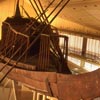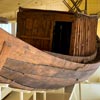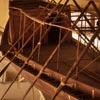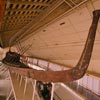
Explore a Pharaoh's Boat
In 1954, an Egyptian archeologist discovered an immense, beautifully crafted ship buried in pieces right beside the Great Pyramid of Khufu. Now fully reassembled, this extraordinary royal craft, one of the oldest planked vessels in the world, has revolutionized our understanding of ancient Egyptian shipbuilding and continues to astonish visitors to the Giza Plateau. In this slide show, take a close look at this 4,600-year-old ship of state.—Peter Tyson


|
|
Museum
Inside this building at the foot of the Great Pyramid at Giza stands one of the most magnificent ancient artifacts ever discovered. It was buried in the 26th century B.C., very carefully, in a carved stone pit directly beneath the museum where it now rests. The artifact was interred in honor of Khufu, the pharaoh who built the Great Pyramid, by his son and successor Djedefre. For four and a half millennia, it lay undisturbed in its limestone sarcophagus.
|


|
|
Discovery
In 1954, Egyptian archeologist Kamal el Mallakh, acting on a hunch, dug under a stone wall on the south side of the Great Pyramid. Beneath a layer of earth mixed with wood chips, charcoal, and powdered limestone, Mallakh revealed a row of 40 limestone blocks lined up like sardines in a can. The stones covered a rectangular, rock-cut pit. Carving an exploratory hole in one of the blocks, Mallakh peered below. This photo, taken at the time, shows what he saw there: well-preserved wooden planks and oars, draped with the remains of matting and ropes and still smelling of cedar.
|


|
|
Ship
This is what Mallakh had found, as it appears today, reassembled, in the so-called Solar Boat Museum next to the Great Pyramid. The 144-foot-long vessel is known variously as the Khufu boat, the solar barque, or the pharaoh's ship. Realizing the treasure he had on his hands, Mallakh took 20 months to remove the boat's 1,224 separate pieces. Then a fellow Egyptian, Hag Ahmed Youssef Moustafa, a conservator for the Egyptian Antiquities Organization, led a team that painstakingly reconstructed the vessel.
|


|
|
Planking
Boatbuilders today typically frame a vessel first, then add the hull's planking. The Khufu boat was shell-built, meaning the outer skin of planks came first, then the interior timbers and framing. The workmanship is exceptional. The pharaoh's craftsmen shaped the ship's 30 hull planks from logs as long as 76 feet. They also sculpted the planks to follow the shape of the hull, and they joggled them along the edges, meaning they carved them in such a way that they lock together like puzzle pieces.
|


|
|
Wood
Fully 95 percent original, the wood of Khufu's boat is conifer, probably cedar of Lebanon. Having few large trees of their own besides Nile acacia and tamarisk, the ancient Egyptians had imported cedar from the eastern Mediterranean region since before Khufu's time. The pharaoh's workers axed and sawed raw logs then trimmed them with adzes, much as traditional Egyptian boatbuilders do today. This detail of the ship's deckhouse displays the fine workmanship the ancients achieved with their copper and flint tools.
|


|
|
Fastenings
The Khufu boat features no nails. Along with the puzzle-piece joggling, its builders connected adjacent planks with mortise-and-tenon joints, a kind of peg-in-hole technique. They also lashed the hull planks together with rope made from a grass called halfa. (Here, an original knot tied by pharaonic shipbuilders.) They didn't wrap the rope around or through the hull planks, which might have promoted leaks. Rather, they worked it through thousands of V-shaped channels they laboriously carved into the inside faces of planks. In essence, they sewed the ship together.
|


|
|
Deckhouse
On the deck stands a roofed, windowless deckhouse about 30 feet long. Within it is a seven-foot-long inner chamber. Was Khufu's body placed here for transport across the Nile for interment in the Great Pyramid? Was the pharaoh meant to find shelter here while traveling in the afterlife? As with everything else regarding the ship's function, the intended use of the deckhouse remains unknown.
|


|
|
Paneling
Khufu's craftsmen appear to have designed the deckhouse for easy disassembly: The structure consists of 22 prefabricated, individually framed cedar panels. Some scholars have drawn on this point to suggest that the ship was never meant to be used in this world, but rather to be interred with the pharaoh for use in the afterlife. This ship and another, in fact—a second dismantled boat lies in another rock-cut pit nearby, unexcavated.
|


|
|
Oars
Each of the Khufu boat's 12 oars was carved from a single piece of wood. Ten oars are lashed amidships ahead of the deckhouse, though this positioning is arbitrary: where, or even whether, the oars were affixed is unknown. A final pair attaches to the stern as steering oars. Steering oars such as these appear in funerary carvings and paintings (see final image), and on ship models, right into the New Kingdom, a thousand years and more after Khufu's time.
|


|
|
Deck
The ship is almost fully decked within the area bounded by the stringers, the curved timbers seen here against which the oars are lashed. The decking itself consists of panels of mortise-and-tenon-joined planks. As seen here, a wooden framework extends out from the deckhouse. It might have held a mat or linen canopy, possibly for evaporative cooling—moistening the covering would have created an insulated cooler space within.
|


|
|
Style
The Khufu boat is known as a papyriform vessel, because the high ends resemble those of papyrus boats. Papyrus is a tall sedge that the Egyptians relied on to make boats as well as cordage, sandals, mats, and other products. Papyriform boats, commonly seen in paintings and carvings of the dynastic period, were ceremonial: They were used for journeys to sacred sites and by the gods. As can just be made out here, in the ship's prow stood a second, wood-framed canopy. Again, its intended use is unknown.
|


|
|
Purpose
Over a half century after the boat's discovery, scholars still debate its purpose. Some say the vessel is a solar barque, which Khufu would have used in his persona as the sun god Re during his daily voyages across the sky. Others feel the ship was a funerary craft for transporting Khufu's body on the Nile to the Giza necropolis or on a final pilgrimage to holy sites. (Here, a funerary barge as depicted in the Book of the Dead of Heruben.) Like much else surrounding this magnificent creation, its function remains an enigma.
|
|


We recommend you visit the interactive version. The text to the left is provided for printing purposes.
|













